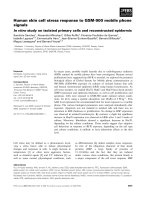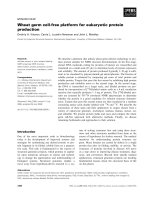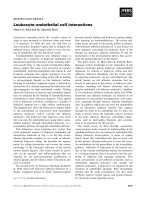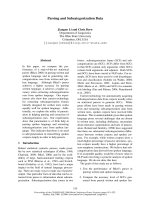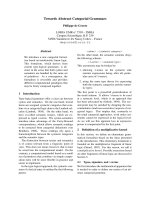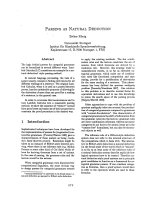Báo cáo khoa học: Leukocyte–endothelial cell interactions pot
Bạn đang xem bản rút gọn của tài liệu. Xem và tải ngay bản đầy đủ của tài liệu tại đây (645.77 KB, 2 trang )
MINIREVIEW SERIES
Leukocyte–endothelial cell interactions
Martin K. Wild and M. Gabriele Bixel
Leukocytes constantly patrol the vascular system in
order to react promptly to infections when and where
it is necessary. To fulfil this task, the cells have to
enter secondary lymphoid organs and to emigrate into
inflamed tissues, which requires them to cross the bar-
rier of endothelial cells that line blood vessels.
Transendothelial migration into inflamed tissues is
preceded by a sequence of leukocyte–endothelial cell
interactions, generally referred to as the ‘multistep adhe-
sion cascade’ (Fig. 1). The cascade is initiated by inflam-
matory signals that cause local activation of vascular
endothelium. Activated endothelial cells express E- and
P-selectin molecules that capture leukocytes from the
bloodstream and mediate rolling of the cells by binding
to glycoconjugate ligands on the leukocyte surface.
Homing to secondary lymphoid organs is initiated by
interactions of L-selectin (expressed by leukocytes) with
glycoconjugates on high endothelial venules. Rolling
allows the leukocytes to perceive and accumulate signals
that are mediated by the binding of endothelial-bound
chemokines to their leukocyte receptors. These signals
lead to leukocyte activation, resulting in a transfer of
leukocyte integrins into a high affinity conformation.
The integrins now allow the leukocytes to adhere firmly
to the endothelium by interactions with intercellular
adhesion molecule-1 and ⁄ or vascular cell adhesion
molecule-1. The leukocytes then migrate to sites where
they can cross the endothelial layer, using either a para-
cellular pathway through intercellular junctions, or a
transcellular pathway through the endothelial cell body.
This minireview series comprises five reviews that
cover important aspects of leukocyte–endothelial cell
interactions (indicated in Fig. 1). In the first review,
Markus Sperandio considers in vivo results on selectin-
mediated leukocyte rolling. He describes the require-
ments for rolling interactions and reviews the current
knowledge of the functional relevance of the various
known selectin ligands. This review focuses in partic-
ular on the glycosyl- and sulfotransferases that are
required for the post-translational modification of
selectin ligands and for which a series of knockout ani-
mals is available.
The second review, by Sviatlana Yakubenia & Martin
K. Wild, deals with leukocyte adhesion deficiency II, a
human congenital disease in which hypofucosylation
prevents selectin binding and leukocyte capture ⁄ rolling,
thus inducing an immunodeficiency. The review des-
cribes recent advances on the genetic defects in patients
with leukocyte adhesion deficiency II. It also focuses on
open questions concerning the molecular basis of the
therapy for leukocyte adhesion deficiency II and the
mechanisms of the developmental defects that accom-
pany the immunodeficiency in this disease.
The third review, by Bjo
¨
rn Petri & Gabriele Bixel,
discusses current knowledge on the interaction of cell
adhesion molecules during leukocyte transendothelial
migration. In contrast to leukocyte rolling and firm
adhesion, leukocyte diapedesis, and the routes taken
by migrating leukocytes, are less well understood. The
article focuses on cell adhesion molecules that are
known to participate in the process of leukocyte extra-
vasation, including cell surface molecules such as
platelet ⁄ endothelial cell adhesion molecule-1, members
of the junctional adhesion molecule family and CD99.
Junctional cell adhesion molecules are believed to be
important for paracellular transmigration, with leuko-
cytes squeezing through between adjacent endothelial
cells. In addition, leukocytes can cross the endothelium
via an alternative pathway whereby they migrate
through the body of an endothelial cell. To date, not
much is known about the molecular players involved
in the latter pathway. However, endothelial compo-
nents, such as intermediate filaments and caveolae,
seem to be important for this process.
The fourth review, by Peter Hordijk, summarizes
recent progress made towards an understanding of the
signaling pathways that are induced in endothelial cells
during leukocyte extravasation. A series of studies
clearly shows that endothelial cells play an active role
in this process, allowing leukocytes to cross the vascu-
lar endothelium via the paracellular or the transcellular
pathway. Adhesion of leukocytes to the luminal sur-
face of the vascular endothelium induces the formation
of a docking structure that is associated with the clus-
tering of adhesion and signaling molecules. This
local concentration of cell adhesion molecules, such as
intercellular adhesion molecule-1 and vascular cell
adhesion molecule-1, is believed to be required for the
initiation of endothelial signaling. Both intracellular
calcium and the actin cytoskeleton, but also small
GTPases, reactive oxygen species and protein kinases,
are involved in these signaling events.
doi: 10.1111/j.1742-4658.2006.05436.x
FEBS Journal 273 (2006) 4375–4376 ª 2006 The Authors Journal compilation ª 2006 FEBS 4375
The final review (by Nicole Kaneider, Andrew Leger
and Athan Kuliopulos) of our series addresses thera-
peutic strategies that aim to interfere with leukocyte–
endothelial cell interactions in order to limit the pro-
gression of inflammatory diseases, such as arterioscler-
osis, rheumatic arthritis and multiple sclerosis.
Although recruitment of leukocytes to the site of
injury or infection is a physiological response, cell infil-
tration into healthy areas, or overzealous leukocyte
accumulation, can have adverse consequences for the
surrounding tissue and contribute to a wide variety of
inflammatory diseases. This article summarizes current
clinical therapeutic strategies and anti-inflammatory
drugs that interfere at various stages of the multistep
adhesion cascade.
The five contributing minireviews reflect the recent
progress in our understanding of leukocyte–endothelial
interactions during the past few years. We are confid-
ent that this knowledge will help to open new avenues
of immunomodulation for therapeutic purposes.
Fig. 1. The multistep leukocyte adhesion cascade and topics covered by this minireview series. The figure depicts the cascade of leuko-
cyte–endothelial cell interactions that leads to leukocyte emigration from blood vessels into tissues. The endothelial layer covering the
lumenal side of vessels is shown in orange with some of the important surface molecules expressed upon activation. The topics of the five
reviews in this series are indicated by arrows. LAD II, leukocyte adhesion deficiency II.
M. Gabriele Bixel is a senior scientist at the Max Planck Institute of Molecular Biomedicine, Mu
¨
nster, and the Insti-
tute of Cell Biology, ZMBE, of the Mu
¨
nster University. She received her PhD in biochemistry in 1998 from the Uni-
versity of Tu
¨
bingen. During her postdoctoral training at the Free University of Berlin she investigated the modulation
of neuroreceptor function by noncompetitive inhibitors. Since 2001, her research has focused on the molecular
mechanisms involved in leukocyte recruitment from the circulating blood into the tissue during inflammation.
Martin K. Wild is a senior scientist at the Max Planck Institute for Molecular Biomedicine, Mu
¨
nster, and the Insti-
tute of Cell Biology, ZMBE, of Mu
¨
nster University. He completed his PhD at the German Cancer Research Cen-
ter in Heidelberg before he moved to Oxford, UK, where he undertook postdoctoral research at the Sir William
Dunn School of Pathology. His current research focuses on human leukocyte adhesion deficiencies, immune
interventions and dendritic cell migration.
Leukocyte–endothelial cell interactions M. K. Wild and M. G. Bixel
4376 FEBS Journal 273 (2006) 4375–4376 ª 2006 The Authors Journal compilation ª 2006 FEBS


